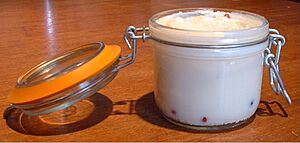Tallow facts for kids
Tallow is a type of fat that comes from animals, mostly beef or mutton. It's made by a process called rendering, which means melting down the fat to separate it from other parts. Tallow is mainly made of triglycerides, which are a kind of fat molecule.
In big industries, the word "tallow" can also mean other animal fats, or even plant fats, as long as they meet certain technical rules, like how hot they need to be to melt. Sometimes, commercial tallow might include fat from pigs (called lard) or plants.
After the fat is melted down, the solid bits left behind are called cracklings or greaves. These are often used as animal feed, for example, in dog food.
In the world of making soap, people sometimes use the name tallowate for soaps made from tallow. For instance, sodium tallowate is created when tallow reacts with chemicals like sodium hydroxide (also known as lye). It's mostly a mix of sodium salts from fatty acids, like oleic and palmitic acids.
Contents
What is Tallow Made Of?
Tallow is 100% fat. It's mostly made up of monounsaturated fats (about 52%) and saturated fats (about 42%). It doesn't contain any water, protein, or carbohydrates.
| Nutritional value per 100 g (3.5 oz) | |
|---|---|
| Energy | 3,774 kJ (902 kcal) |
|
0 g
|
|
|
100 g
|
|
| Saturated | 42 g |
| Monounsaturated | 50 g |
| Polyunsaturated | 4 g |
|
Protein
|
0 g
|
| Other constituents | Quantity |
| Cholesterol | 109 mg |
|
Fat percentage can vary.
|
|
| †Percentages estimated using US recommendations for adults. | |
The main types of fatty acids in tallow are:
- Saturated fatty acids:
- Palmitic acid
- Stearic acid
- Monounsaturated fatty acids:
- Oleic acid
How Tallow is Used
Tallow is mainly used to make soap and food for animals.
In Food
Tallow is often used to make shortening, which is a type of fat used in baking. It's also a key ingredient in pemmican, a traditional food of some Native American groups.
With a smoke point of about 480 degrees Fahrenheit (249 degrees Celsius), tallow is great for deep frying. It was a popular choice for frying until plant-based oils became more common. For example, before 1990, McDonald's used a mix of beef tallow and cottonseed oil to cook its French fries. Other fast-food chains like Burger King and Wendy's also used tallow for frying. Today, tallow is becoming popular again in some cooking circles.
Greaves
Greaves, also known as cracklings, are the leftover fibrous bits after rendering fat. They are often pressed into cakes and used as animal feed, especially for dogs and hogs. They can also be used as fishing bait.
As Fuel
Biodiesel
Tallow can be used to create biodiesel, which is a type of fuel made from natural sources. It works in a similar way to how oils from plants are used to make biodiesel.
Aviation Fuel
The United States Air Force has successfully tested using beef tallow in aviation biofuels. In 2010, a U.S. Air Force C-17 Globemaster III aircraft flew using a special blend of regular jet fuel and biofuel made from beef tallow. This showed that tallow could be a source for airplane fuel.
In Printing
Tallow is used in printmaking. It's mixed with bitumen and put on metal printing plates to stop acid from etching certain areas.
Since 2016, small amounts of tallow have been used in the material for polymer banknotes (plastic money). This affects banknotes in many countries, including Canada, Australia, and the United Kingdom.
For Candles
Long ago, tallow was widely used to make candles. They were a cheaper option compared to candles made from wax. For people who couldn't afford molded tallow candles, a "tallow dip" was used. This was often a piece of cloth or reed dipped in melted tallow, which would burn like a simple candle.
For Lubrication
In the early days of steam engines, it was hard to find lubricants that wouldn't wash away easily. Tallow was found to be very good at resisting this. Tallow was widely used to lubricate engines in trains and steamships until at least the 1950s. Today, tallow is still used in the steel rolling industry to help lubricate the sheet steel as it's pressed.
Tallow is also used as a lubricant for some light engineering tasks, like cutting threads on pipes. While special cutting compounds exist, tallow is a traditional and easy-to-find option.
A historical event involving tallow was the start of the Indian Mutiny of 1857. Soldiers believed that the paper cartridges for their new rifles were greased with animal fat, which caused a major problem due to religious beliefs. Tallow was also used as a lubricant for ammunition during the American Civil War.
Tallow can also be used to make a type of biodegradable motor oil. It is also used in traditional bell foundry to help separate parts when casting bells.
In Industry
Tallow can be used as a flux for soldering, which helps metal parts join together.
In Textiles
Mutton tallow is often used in making textiles. It acts as a starch, lubricant, and softener. In a process called "sizing," a chemical is needed to make yarns strong enough for weaving on a loom. Mutton tallow provides this strength and lubrication for the yarns.
See also
- Suet
- Dripping




